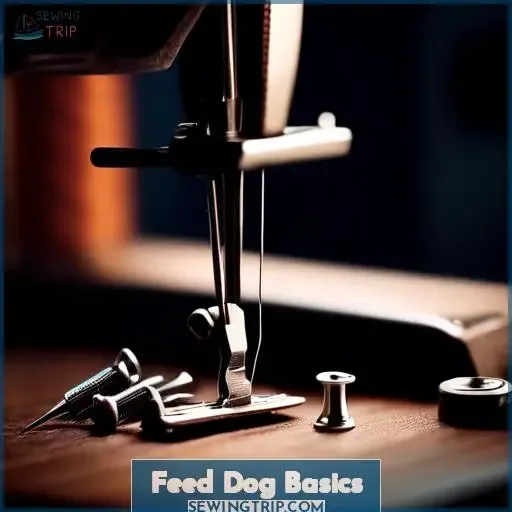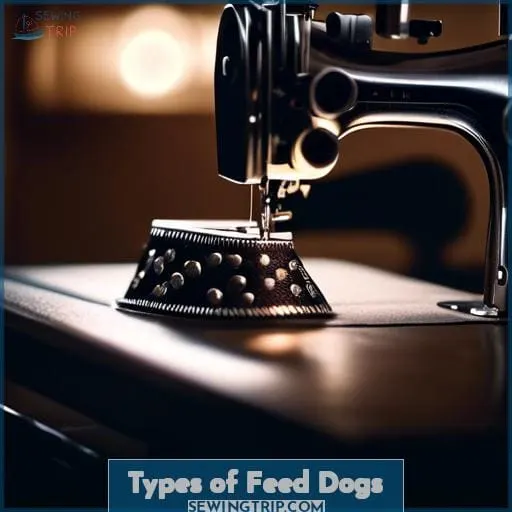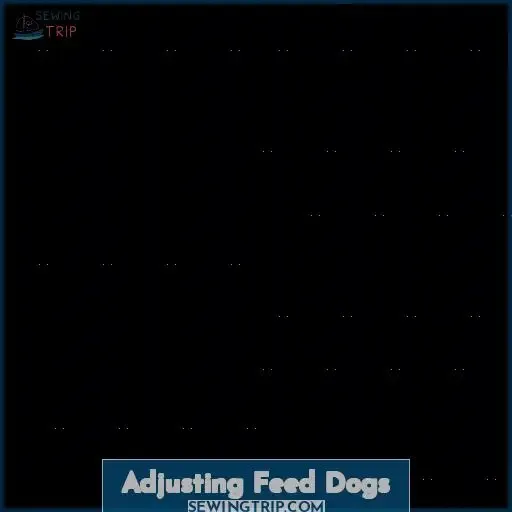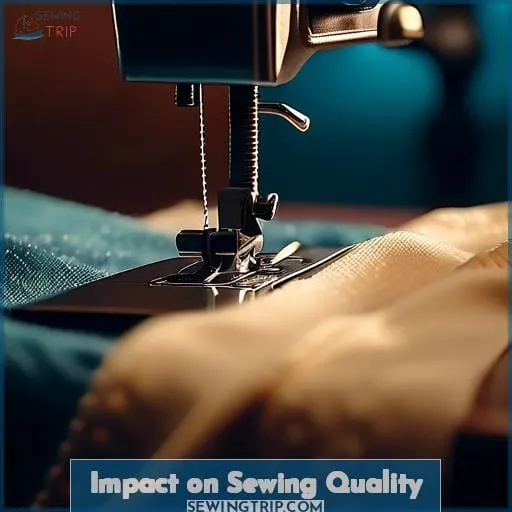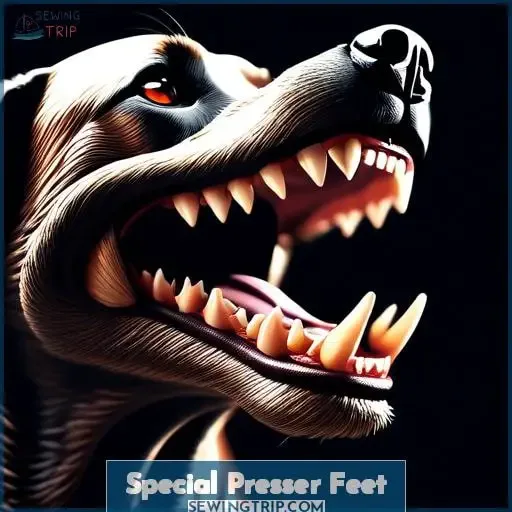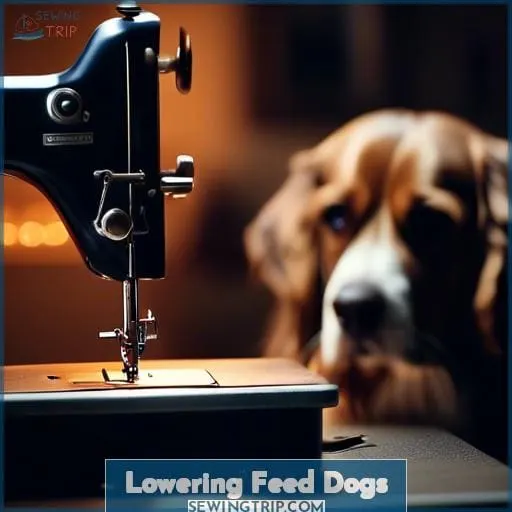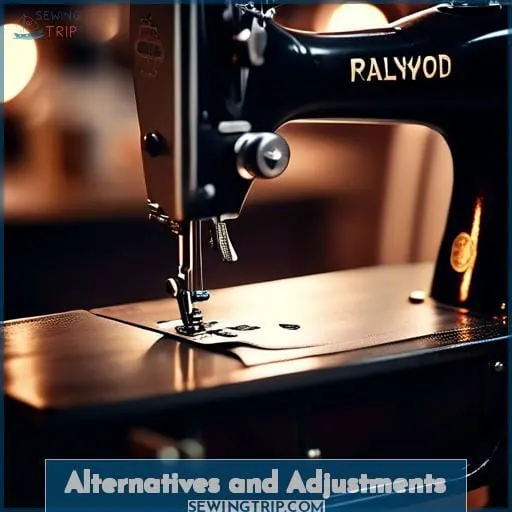This site is supported by our readers. We may earn a commission, at no cost to you, if you purchase through links.
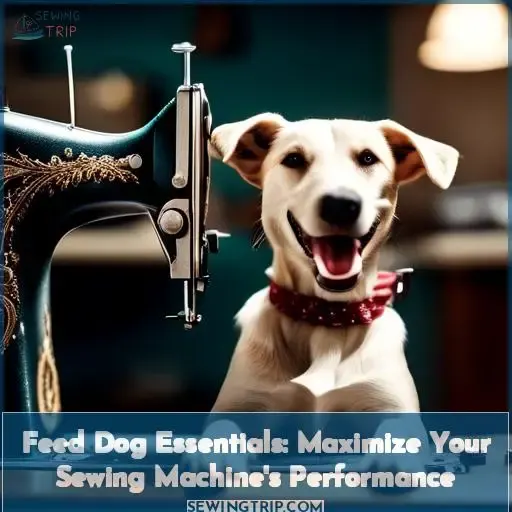 In the intricate dance of sewing, feed dogs are the unsung heroes, quietly ensuring every stitch is a step towards perfection.
In the intricate dance of sewing, feed dogs are the unsung heroes, quietly ensuring every stitch is a step towards perfection.
These metal teeth-like ridges guide your fabric with precision, transforming your sewing machine into a reliable partner for your creative endeavors.
Whether you’re a seasoned tailor or a budding seamstress, understanding and mastering your machine’s feed dogs can elevate your sewing game, allowing you to tackle any project with confidence and finesse.
A feed dog on a sewing machine is a set of metal teeth-like ridges that move fabric through the machine in precise steps between stitches.
Table Of Contents
Key Takeaways
- Feed dogs are metal teeth-like ridges located on the throat plate of a sewing machine, essential for moving fabric through the machine to produce high-quality stitches by gripping the bottom fabric.
- There are various types of feed dogs, including center, differential, walking foot, drop, and needle feed dogs, each designed to handle different sewing tasks and fabric types, from maintaining center stitches to allowing free motion quilting.
- Adjusting feed dogs is crucial for optimal sewing machine performance, involving height and position adjustments, regular cleaning and oiling, and pressure adjustments to prevent fabric puckering and ensure even fabric feeding.
- The proper adjustment and maintenance of feed dogs significantly impact sewing quality, preventing fabric puckering and stretching, ensuring even stitches, and allowing for adjustments based on different fabric types.
Feed Dog Basics
Feed dogs are a crucial component of a sewing machine, acting as metal teeth-like ridges that emerge from the machine’s throat plate. Their primary function is to grip the bottom fabric and assist it in moving through the machine, ensuring the production of high-quality stitches.
As you sew, the feed dogs move in a synchronized manner with the sewing needle, gripping the fabric to control its passage and maintain consistent stitch length. This mechanism is essential for achieving uniform stitches and is a fundamental aspect of sewing machine operation, impacting both the quality of the stitch and the accuracy of the seam.
Definition and Function
Feed dogs are essential components of a sewing machine, acting as metal teeth-like ridges that emerge from the throat plate. Their primary function is to grip the bottom fabric, guiding it smoothly through the machine to ensure high-quality, consistent stitches.
This mechanism is crucial for maintaining even fabric feeding, preventing puckering and stretching, and achieving accurate seam quality. Various types of feed dogs, such as center, differential, and walking foot feed dogs, cater to different sewing needs, allowing adjustments for fabric type and sewing technique.
Regular maintenance, including cleaning and oiling, is vital for optimal performance. Special presser feet, like the darning foot for free-motion quilting or the walking foot with built-in feed dogs, complement the feed dog mechanism, enhancing sewing quality for specific tasks.
How They Work
Feed dogs are crucial components in the mechanics of a sewing machine, serving a fundamental role in fabric manipulation to ensure even stitching. These metal teeth-like ridges, located at the base of the sewing machine’s throat plate, engage the fabric to move it through the machine in precise increments between stitches.
This movement is synchronized with the needle’s action, allowing for consistent stitch length and quality. The feed dogs work in tandem with the presser foot, holding the fabric securely to prevent puckering or stretching, thus directly impacting the quality of the stitch and the accuracy of the seam.
Modern sewing machines often feature adjustable feed dogs, allowing users to modify their height and position to accommodate different types of fabric, further enhancing sewing quality and versatility.
Types of Feed Dogs
Understanding the various types of feed dogs on a sewing machine is crucial for maximizing your machine’s performance. Feed dogs are the metal teeth-like components that help move the fabric through the sewing machine, ensuring even feeding and consistent stitch quality.
The main types include:
- Center feed dogs
- Differential feed dogs
- Walking foot feed dogs
- Drop feed dogs
- Needle feed dogs
Each type is designed to cater to different sewing needs and fabric types.
Center Feed Dogs
In your sewing machine, the center feed dog plays a pivotal role in fabric movement. It works in tandem with the center needle to ensure that the fabric is fed through the machine evenly, maintaining a consistent center stitch.
This is crucial for achieving a high-quality seam and preventing fabric puckering.
To optimize performance, you may need to adjust the center feed dog’s height and position, especially when working with different fabric types. Remember, for most sewing tasks, the feed dogs should be up and visible, actively engaging with the fabric under the center presser foot.
However, when you’re delving into free motion quilting or darning, you might lower the feed dogs or cover them to gain full control over the fabric movement.
Differential Feed Dogs
Differential feed dogs on a sewing machine play a crucial role in fabric manipulation, stitch length control, and enhancing quilt embellishments.
These specialized feed dogs ensure precise feeding of multiple layers of fabric, particularly when using a walking foot.
By adjusting the height and position of these feed dogs, you can master the art of top-stitching and achieve impeccable sewing results on various fabric types.
Walking Foot Feed Dogs
When tackling uneven, bulky, or slippery fabrics, a walking foot can be your ally. This foot, equipped with its own set of feed dogs, works in tandem with your machine’s lower feed dogs to ensure that all layers of fabric move through the sewing machine at the same pace.
This synchronization is particularly beneficial when sewing stretchy materials like knits or when managing multiple layers, as in quilting or when sewing a face mask. Unlike the darning foot used for freehand quilting, where you lower the feed dogs for more maneuverability, the walking foot keeps them engaged, providing stability and preventing fabric shifting.
For industrial sewing machine tasks or when working with thin fabrics, the walking foot helps maintain stitch quality without the fabric puckering or stretching. It’s a versatile tool that adapts to various sewing challenges, ensuring your projects turn out with professional precision.
Drop Feed Dogs
Transitioning from the walking foot’s built-in feed dogs, let’s delve into drop feed dogs, a feature that enhances your sewing machine’s versatility.
When you’re aiming for precision in free motion quilting or sewing intricate seams, the ability to drop feed dogs is invaluable. This alternative to the traditional feed mechanism allows for unimpeded movement of the fabric, giving you full control over stitch placement and length.
While it’s true that dropping feed dogs can impact tension and timing, it’s a trade-off for the freedom it provides in free motion work. However, not all machines handle this function equally, and some sewists find that maintaining feed dogs in an elevated position offers better stitch quality and fewer issues.
It’s worth experimenting with your machine’s settings to discover the optimal configuration for your specific quilting or sewing projects.
Needle Feed Dogs
Transitioning from the topic of dropping feed dogs, let’s delve into needle feed dogs, a crucial component for handling specialty fabrics and unique applications.
Unlike traditional feed dogs that move fabric from below, needle feed dogs work in tandem with the needle, advancing the fabric as the needle moves up and down. This synchronized movement is particularly beneficial for embroidery and fabric manipulation, ensuring smoother fabric handling and superior stitch quality.
Ideal for working with delicate or slippery fabrics, needle feed dogs minimize fabric shifting and puckering, offering you the precision needed for intricate designs and applications.
Embrace the innovation of needle feed dogs to elevate your sewing projects, harnessing their capability to tackle specialty fabrics with ease and finesse.
Adjusting Feed Dogs
Feed dogs are a crucial component of your sewing machine, responsible for moving the fabric through the machine to create even stitches.
Adjusting the height and position of feed dogs can significantly impact your sewing machine’s performance, especially when transitioning between different fabric types or thicknesses.
Regular maintenance, including cleaning and oiling your feed dogs, ensures they function smoothly and prolongs the life of your machine.
Height and Position Adjustments
After exploring the various types of feed dogs, it’s crucial to understand how adjusting their height and position can enhance your sewing.
Proper feed dog height ensures the teeth grip fabric effectively, while position adjustments align with special presser feet for optimal fabric compatibility.
Adjusting pressure can prevent puckering, improving the stitch surface for tasks like darning with an even feed presser foot.
Maintenance: Cleaning and Oiling
To maintain your sewing machine’s feed dogs, regular cleaning and oiling are essential. Accumulated lint and dust can impede their movement, leading to poor stitch quality.
Carefully remove debris from the feed dogs with a small brush or compressed air. Apply sewing machine oil as directed by your machine’s manual to ensure smooth operation.
Over time, feed dogs may wear down and require replacement to maintain optimal performance. Adjust feed dog settings to accommodate various fabric types, enhancing your machine’s longevity and ensuring consistent stitch quality.
Impact on Sewing Quality
In the article Feed Dog Essentials: Maximize Your Sewing Machine’s Performance, adjusting the feed dogs’ height and angle is crucial for fabric feeding.
Understanding these adjustments optimizes stitch quality and seam accuracy, enhancing your sewing experience.
Stitch Quality and Seam Accuracy
Feed dogs are critical components in your sewing machine, directly influencing stitch quality and seam accuracy. Proper feed dog maintenance ensures even fabric feeding, preventing puckering and stretching, which is vital for consistent stitch length.
Over time, wear and tear may necessitate feed dog replacement to maintain optimal sewing performance. Different fabric types impact how feed dogs interact with your material, so adjusting their height and position can improve sewing quality.
Additionally, thread tension adjustment plays a significant role; too tight and your fabric may pucker, too loose and seams may not hold. Always consider the fabric type and adjust stitch length and tension accordingly for the best results.
Fabric Feeding and Puckering Prevention
To prevent puckering and ensure smooth fabric feeding, regular feed dog maintenance is essential.
Adjusting feed dog height and position can significantly improve fabric feeding quality. If you notice uneven stitches or puckering, consider feed dog replacement with ones suited for your fabric type.
Properly set feed dogs work in harmony with the presser foot, preventing fabric stretching and ensuring consistent stitch length for a flawless finish.
Special Presser Feet
In exploring the role of feed dogs in your sewing machine’s performance, it’s crucial to consider the impact of special presser feet.
A darning foot facilitates free motion quilting and embroidery by allowing more control over stitch placement.
A walking foot, equipped with its own feed dogs, ensures even fabric feeding for layers that move together seamlessly.
These tools are essential for enhancing stitch quality and fabric handling in various sewing projects.
Darning Foot for Free Motion
As you transition from ensuring the quality of your stitches to exploring the realm of free motion quilting, consider the darning foot as your ally. This special presser foot is designed to float above your quilt, giving you the freedom to steer the fabric in any direction.
- Utilize a darning foot for superior fabric control methods.
- Experiment with stitch length settings to find the sweet spot for your thread weight.
- Check machine compatibility to ensure smooth operation.
- Explore darning foot alternatives if your machine doesn’t support feed dog lowering.
Walking Foot With Built-in Feed Dogs
When using a walking foot with built-in feed dogs for free motion quilting, ensure to adjust stitch length for optimal results. This foot aids in even feeding, maintaining thread tension, and enhancing stitch quality.
By seamlessly moving fabric layers, it prevents bunching and ensures precise stitching. Consider the genuine Brother walking foot for compatibility and superior performance.
Lowering Feed Dogs
When you’re ready to tackle freehand quilting or darning, you’ll need to consider the role of your sewing machine’s feed dogs.
These metal teeth-like components are crucial for guiding fabric and ensuring even stitches during most sewing tasks, but for certain freehand work, you may find it beneficial to lower them.
Depending on your machine, this can be done via a switch, a special plate, or even makeshift covers for models without a lowering feature, giving you full control over stitch placement and length.
Methods Across Different Machines
To address the subtopic of ‘Methods Across Different Machines (Lowering Feed Dogs)’ in the context of the article ‘Feed Dog Essentials: Maximize Your Sewing Machine’s Performance’, it’s important to understand that feed dog accessibility and the ability to lower or cover them varies across different sewing machine brands and models.
For those machines that don’t allow feed dogs to be lowered, drop feed dog alternatives such as using a special plate or even household items like plastic cards can be employed. Regular feed dog maintenance is crucial for ensuring smooth fabric feeding and stitch quality.
For sewers looking to enhance their machine’s performance, feed dog upgrades or adjustments may be necessary. Hidden feed dogs, when not in use, can facilitate certain sewing techniques like free-motion quilting, where the sewer controls fabric movement.
When to Lower for Darning and Quilting
After mastering the methods to lower your feed dogs, you’re ready to tackle free motion quilting.
This technique, while liberating, can introduce tension issues and thread breaks if not managed properly.
By keeping the feed dogs down, you gain full control, allowing for smoother stitches and a more enjoyable quilting experience.
Alternatives and Adjustments
In the realm of sewing, understanding and optimizing the performance of your machine’s feed dogs can significantly enhance your sewing experience, especially when working with various fabric types or undertaking specific tasks like free motion quilting.
Adjusting the height and angle of feed dogs, as well as considering their replacement for tasks that demand a different kind of fabric feed, are crucial steps for achieving the best stitch quality and fabric handling.
Whether you’re adjusting for lightweight fabrics or swapping out feed dogs for heavy-duty sewing, these modifications ensure your machine operates smoothly and efficiently, tailored to the specific needs of your project.
Adjusting for Different Fabric Types
When tackling various fabric types, adjusting your feed dog height and position is crucial.
Needle feed dogs can be particularly beneficial for consistent stitch quality. Remember, each fabric demands specific settings; mastering these adjustments will enhance your sewing precision and elevate your craft to new levels of innovation and quality.
Replacing Feed Dogs for Specific Tasks
When considering replacing feed dogs for specific tasks, it’s essential to understand that specialty feed dogs can significantly enhance your sewing machine’s performance.
Compatible feed dogs are designed to meet the unique demands of various fabrics and sewing techniques. For instance, aftermarket feed dogs might offer a better grip on slippery materials or ensure smoother fabric feeding for quilting projects.
Opting for a feed dog upgrade can be a game-changer, especially if you’re working with diverse fabric types or require precise stitch quality. Always ensure the replacement feed dogs are compatible with your sewing machine model to avoid any functionality issues.
Frequently Asked Questions (FAQs)
Can sewing machine feed dogs be replaced if they become worn out, and how is this done?
Yes, sewing machine feed dogs can be replaced if they become worn out. This typically requires disassembling the machine to access the feed dogs, removing the old feed dogs, and installing new ones.
It’s a technical process that might involve adjusting the height and alignment of the new feed dogs to ensure smooth fabric feeding. For precise steps, consulting the machine’s manual or a professional technician is recommended, as procedures can vary by model.
Are there specific fabrics or materials that should not be sewn with feed dogs engaged due to potential damage?
Yes, delicate fabrics like silk, chiffon, and lightweight knits should be sewn with caution when feed dogs are engaged.
They can snag or damage these materials.
Use a stabilizer or tissue paper underneath to prevent issues.
How do environmental factors, such as humidity or dust, affect the performance of feed dogs over time?
Humidity and dust can significantly impact feed dogs’ performance, leading to fabric feeding difficulties, increased wear, and potential for clogging.
Regular cleaning and adjustments are essential to maintain optimal function and prevent issues like thread catching or fabric movement problems.
Is there a difference in feed dog performance between mechanical and computerized sewing machines?
Mechanical sewing machines typically feature a standard feed dog system that moves fabric forward with basic options for dropping feed dogs for specific tasks.
In contrast, computerized machines often have advanced feed dog mechanisms. These mechanisms allow for precise adjustments in height or complete deactivation, providing greater control over fabric movement for various sewing techniques.
Can the use of certain threads, like metallic or very thick ones, cause issues with feed dog functionality?
Using metallic or very thick threads can indeed cause issues with feed dog functionality. These threads may not move smoothly through the machine, leading to tension problems, thread breaks, or even damage to the feed dogs or other machine parts.
Adjustments in machine settings, such as tension or presser foot pressure, and using the correct needle size can help mitigate these issues.
Conclusion
Navigating the fabric of your sewing projects, feed dogs are the compass guiding you through the wilderness of stitches.
You’ve learned how these essential components work, their types, and how to adjust them for peak performance.
With proper maintenance and understanding, your sewing machine’s feed dogs will ensure each seam is a testament to your craftsmanship.

